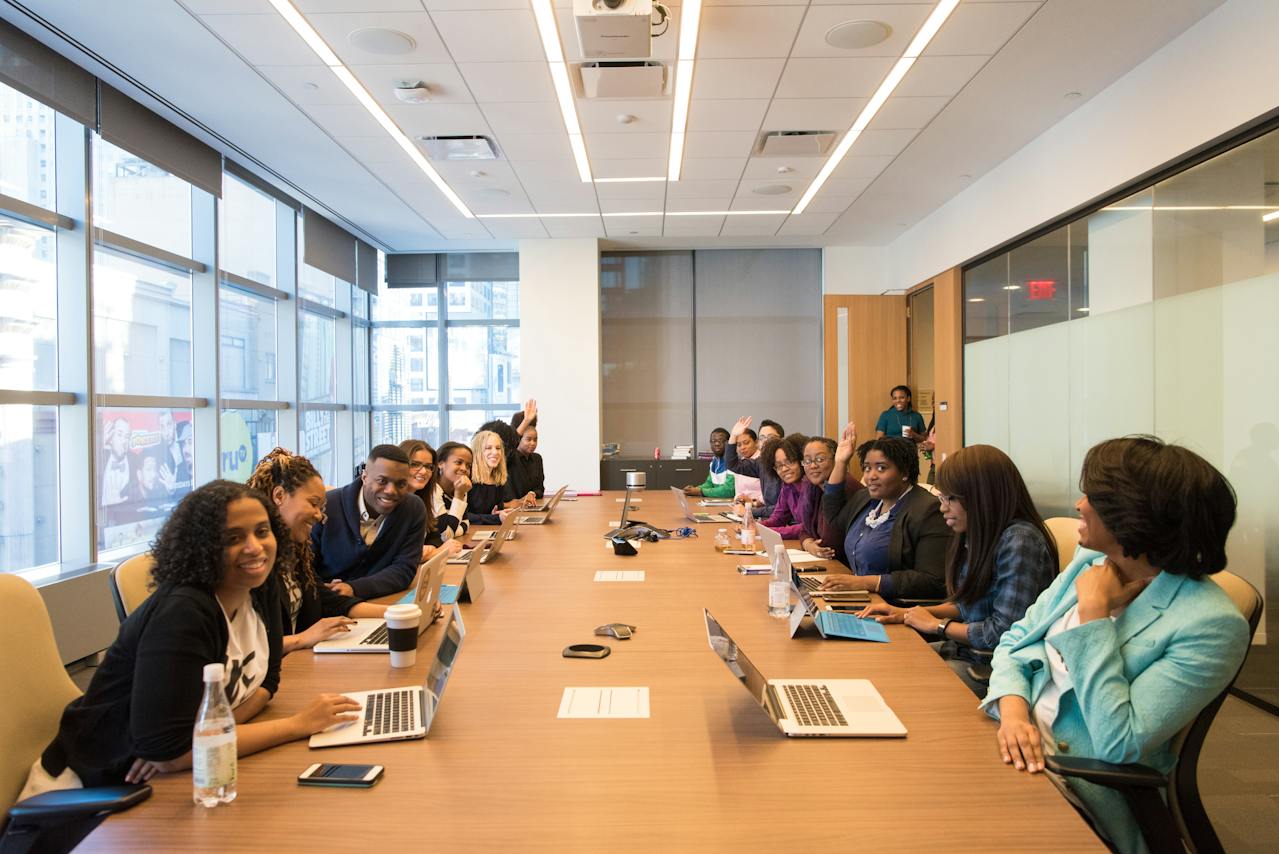The article’s title sounds so paradoxical, right? It feels like since we are attending more work meetings, it should always result in a more productive day. However, that is not always the case. Many employees strive to have workplace collaboration that strikes a balance between appointments and actual productive tasks.
Hence, we will be introducing some productivity hacks that you can apply to your journey and shed light on how to value everyone’s time and maximize the benefits of teamwork without impeding productivity at work.
⸻
Today, the modern workplace highly values cooperation, knowing that good teamwork is always critical to one’s business success. It is great that many employers urge employees to collaborate, breaking down divisions and promoting an open communication culture. In numbers, workplace collaboration has grown by at least 50% in the last 20 years. Amidst the constant struggles of systemizing work and collaborative tasks, the emergence of productivity tools immensely helps in building a better environment for everyone. With these accessible tools, work productivity can swell up benefits and diminish anxiety, wasted efforts and time, and overloading of tasks.
Collaborative tools and technology have become essential, allowing remote and face-to-face teams to easily transfer information, ideas, and concerns. This point not only boosts innovation and problem-solving, but it also fosters a sense of camaraderie and shared purpose among employees, resulting in heightened productivity and growth for the company.
Moreover, while meetings are crucial to business communication and decision-making, their overuse can have serious consequences. Prolonged regular meetings might reduce productivity by wasting important work hours that might have been spent on projects instead. In addition, appointments can contribute to workplace fatigue and lower staff morale, resulting in burnout and a fall in overall employee happiness. To avoid these possible drawbacks, many companies are encouraged to leverage different productivity tools and foster workplace collaboration beyond boundaries while maintaining a balance between meetings and personal pursuits.
The Rise of the Collaborative Workplace

In the history of the design of workplaces and cooperation, there has been a considerable transition from self-work towards opening office plans and collaborative projects. Traditionally, work settings emphasized individual, segregated duties, with employees confined to workstations or private offices. However, a revolution happened as firms attempted to improve their creativity, communication, and core values. Workplace collaboration ideas have grown in popularity because they build more connections and cooperation among staff. Additionally, the advancement that technology provides and the necessity for varied skill sets in today’s workforce have pushed firms to adopt team projects, in which cross-functional teams collaborate to solve complicated problems. This movement not only manifests changing work philosophies but also acknowledges the significant role of workplace collaboration and interactions with others in accomplishing professional goals and forming an evolving and inclusive work environment.
On the other hand, workplace collaboration provides a plethora of perceived upsides, making it a highly valuable component of contemporary organizational success. One of the most significant benefits is the development of a better system of work. When people with various experiences and abilities join together, they bring a wide range of thoughts and experiences to the table, stimulating new and groundbreaking solutions to complicated issues. Workplace collaboration also has a considerable effect on creativity and team spirit. When employees collaborate well and feel their contributions are recognized, they develop a sense of being part of something and a sense of shared purpose, which promotes job satisfaction and general well-being. The ties developed among team members enhance a positive work atmosphere even more.
Overall, organizations obtain a broader perspective on issues by actually engaging with colleagues from diverse origins, cultures, and experiences, resulting in diverse decision-making with inclusive solutions. Hence, collaboration not only fosters innovation and creativity but also heightens chemistry and guarantees that a wide array of views have been taken into account in decision-making for the betterment of everyone.
The Allure of Meetings

The primary goal of internal communication remains to improve the flow of details, keep stakeholders up-to-date, and allow effective decision-making. Any successful business relies on clear and efficient communication. It is used to communicate essential facts, updates, and decisions to staff, executives, and other stakeholders, ensuring that everyone stays on the same page and works toward common goals. Effective communication serves as the connecting tissue that unites the entire business and enables timely, knowledgeable decision-making, whether it’s delivering critical information regarding projects, accounts payable, or strategic plans. Communication, in this sense, acts as a foundation for organizational coherence and success, ensuring that the correct information reaches the right people at the right time.
The psychological attractiveness of good workplace communication extends beyond its practical utility; it likewise addresses basic human wants and emotions. Feeling present and “in the loop” can be quite motivating. Individuals feel a sense of belonging and worth when they are kept engaged and active, which increases general job satisfaction and loyalty to the organization. It also reduces the stress that can accompany uncertainty by providing a sense of ownership and stability. Furthermore, communication frequently crosses with the need to look active and involved. Being well-connected and attentive in an environment of rapid change indicates an enduring work ethic and hard work, which peers and superiors can assess positively.
The Dark Side of Over-Collaboration

As mentioned, while meetings are necessary for communication and decision-making, excessive use can lead to decreased productivity, employee dissatisfaction, and even burnout. The time available for real work decreases as the number of meetings increases, affecting how well individuals and teams perform. Furthermore, protracted meetings might result in diminished involvement and focus as members feel tired and disinterested. Excessive meetings, in the end, might degrade the quality of conversations, making it difficult to produce constructive conclusions. To minimize the diminishing results associated with an overload, strike a balance by arranging meetings prudently and ensuring they have clear objectives and efficient arrangements.
In collaborative work situations, the group’s drive for compromise and harmony always contributes to the fruition of distinct ideas and outstanding thoughts. However, there is always a temptation to adhere to the dominant opinion or “group think” that becomes intense and impairs critical thinking and a variety of ideas. This can be harmful since it stifles the dissemination of fresh ideas and inventive solutions. That is why it is always critical to practice an open, welcoming atmosphere that caters to a multitude of ideas and dissenting voices in order to promote a more vibrant and ideal work environment.
The contemporary office faces a contradiction in which people spend more time addressing work than undertaking it. Meetings, emails, and debates, while necessary for cooperation and communication, can become overwhelming at times, leading to an excessive quantity of time spent on preparation and discourse rather than task execution. Because there appears to be little space left for actual work, this paradox can inhibit productivity. Thus, organizations can alleviate this paradox by streamlining communication, avoiding needless meetings, and using productivity tools, ensuring that time devoted to work talks is in sync with time spent engaging in successful, value-added tasks.
Quantifying the Cost of Meetings

Meetings are necessary for cooperation, the exchange of data, and decision-making, but they can also be a big time sink if not managed properly. The case is that many employees become part of a never-ending loop of meetings, which disturbs their workflow and impairs their capability to focus on activities that demand intense concentration.
Moreover, meetings in place of employment have financial consequences that go beyond the cost of conference rooms and refreshments. They include attendance hourly earnings as well as the often-overlooked notion of potential expenses. Employees who spend hours in meetings, particularly those in high-paying roles, have a direct impact on labor expenses. Attendees’ combined salary expenses might be high, especially for long or large-scale meetings. Besides, opportunity costs apply because meeting time is a period that is not utilized for revenue-generating or added-value tasks. The organization foregoes potential income or productivity that could have been generated if that time had been spent on other tasks.
Another overlooked consequence of meetings is highly related to the intangible costs that must also be considered. Excessive meetings can have a negative impact on the well-being of staff members, leading to fatigue as people attempt to combine meeting demands with their real-world tasks. All of these introspective “expenses” have a long-lasting effect on the performance of a company as a whole, affecting not just the bottom line but also the mental health and motivation of its staff, as well as the timely completion of crucial projects.
In general, there is a need to recognize and minimize financial and intangible expenses. Corporations must prioritize efficient, focused meetings and promote a mindful scheduling culture. Employees will be able to devote more of their time to meaningful and productive work that adds to the organization’s fulfillment, rather than feeling weighed down by unnecessary and ineffective meetings that disrupt their flow and limit their efficiency.
The Illusion of Progress

There is a high chance that we confuse activity, especially that which takes the form of meetings, with productivity. Like what has been reiterated here, meetings are essential for teamwork and communication, but they may be a sword with two blades. When businesses overemphasize the number of meetings without examining their real impact, an illusion of development can be shaped. Employees may feel productive solely by attending events, even if those conversations produce insignificant results. This condition can always lead to lost time, decreased efficiency, and a feeling of complacency. The idea of the illusion of progress adds up to the notion of “busyness” or linking being active with merit, which is a common yet deceptive assumption in today’s work culture.
Many people and businesses place a great value on seeming busy, typically as a symbol of commitment and worth. This assumption, however, is fundamentally wrong. Busyness may not always imply productivity, efficiency, or contributions. In reality, a preoccupation with staying busy is capable of causing burnout, diminished creativity, and a lack of balance between work and life. The genuine value of an individual or organization is measured not by the number of hours spent on activities but by the level of performance of those activities, the results obtained, and the positive effect generated.
Striking the Right Balance

The only answer to the concerns posed concerning workplace collaboration and overuse of meetings is striking the right balance. Understanding when a conference meeting is required versus when it is unnecessary is an ability in modern business. Meetings can be effective instruments for communication and decision-making, but they can waste time and resources if they are overdone or held without a clear goal.
Always ask: First and foremost, what is the meeting’s specific aim or outcome? If the answer is unclear or could be obtained through alternative methods, such as a quick email or brief chat, the meeting may be unnecessary. Also, consider whether the agenda of the meeting justifies the time allotted. If the agenda lacks important topics or could be covered more efficiently, it may indicate that the meeting is also unnecessary. Recognizing these aspects enables organizations to gain the most from their use of discussions, ensuring that they are a worthwhile and productive part of the work process rather than a waste of time and energy.
Best practices for efficient, productive meetings:

a. Clear agenda.
Having a clear agenda is a critical standard of excellence for efficient and productive meetings. A well-defined agenda explains the objective of the meeting, the topics to be addressed, and what is expected to happen. It assists participants in arriving prepared, staying on track, and ensuring that the meeting remains focused on its objectives. A precise agenda not only saves time but also improves the meeting’s overall quality and productivity, making it a crucial component of profitable as well as purpose-driven collaboration in any kind of company.
b. Time limits.
Setting time limitations is another recommended practice for better workplace collaboration and effective meetings. Meetings with explicit start and end timings encourage attendees to keep on topic and reduce distractions while making the most of their time. Time constraints help to maintain an impression of urgency, ensuring that talks stay focused and choices are made quickly. This strategy not only increases efficiency but also respects the schedules of participants, making meetings more appealing and productive.
c. Relevant stakeholders only.
Inviting only those relevant stakeholders is an ideal recommendation for a more productive and profitable meeting. Meeting the correct people guarantees that the dialogue is directly tied to the objective of the meeting and that decisions are made quickly. It also eliminates unwanted delays and distractions, leading to a more efficient gathering.
d. Defined outcomes and next steps.
In every meeting, it is important that you have defined your expected outcomes and the next steps that your team will take. From here, you can ensure that you are all aligned with your vision for the company and avoid any disturbances along the way. Once you form a solid goal and process, you will surely minimize unnecessary meetings and delays because your eyes are already set on the shared goal through healthy and easy workplace collaboration.
Alternative Collaboration Strategies

a. Asynchronous communication: emails, task management tools, shared documents.
Asynchronous communication has evolved into an essential component of modern cooperation, providing a variety of alternatives to traditional real-time meetings. Email, task management tools, and shared documents all play important roles in this transformation. Emails provide a flexible means of exchanging information, discussing ideas, and sharing updates without requiring simultaneous presence. Teams can use task management systems to assign and track duties, promoting a systematic and goal-oriented manner of collaboration. These tactics boost productivity and flexibility while meeting the different needs of today’s dynamic, sometimes geographically scattered workforce.
b. Lean methodologies: daily stand-ups, sprints.
Lean approaches stress efficiency and continual improvement, and routine stand-ups and sprints are two essential alternative strategies that complement this collaboration approach. Daily stand-up meetings, which are often done in a short, standing style, allow team members to swiftly share progress, difficulties, and goals, emphasizing transparency and speedy issue resolution. Sprints, on the other hand, are short, focused work cycles that typically span two to four weeks and involve teams tackling specific targets. These tactics promote frequent feedback, quick decisions, and iterative progress. Teams may keep a persistent focus on value, decrease waste, and better communicate in a dynamic and responsive manner by including these alternative workplace collaboration strategies.
c. Relying on collaborative technologies: platforms like Slack, ClickUp, Trello, etc.
Using collaborative tools for productive teamwork has become a main option in the digital age. Slack, ClickUp, Trello, and other platforms enable immediate interaction, the management of tasks, and project tracking. They enable teams to work smoothly, regardless of physical location, and allow for the centralized and structured sharing of knowledge, documents, and updates. For graphic designers or people in the art industry, there are also a variety of image editing services that they can utilize for faster collaboration. If they want instant results, these automated platforms can help edit photos, and serve as a background remover, video editing apps, and more. These collaborative technologies encourage openness, accountability, and the efficient sharing of ideas, thereby increasing productivity and communication in a technology-driven workplace.
d. Encouraging a Culture of Intentional Collaboration.
Fostering an environment where teamwork is meaningful and strategic is part of promoting a culture of purposeful workplace collaboration. This productivity hack method emphasizes deliberate preparation and scheduled interactions over ad hoc encounters or contacts. It encourages teams to think about the “why” of collaboration, ensuring that each connection has a defined purpose and brings triumphs to the organization.
Training and workshops on effective collaboration.

Furthermore, developing a practice of having fewer but more concentrated discussions is a powerful tactic in the context of executive modeling. Leaders who lead by example by choosing quality over quantity in meetings inspire their teams to do the same. Leaders exhibit efficiency and productivity by highlighting the value of well-organized, purpose-driven meetings and building a culture of thoughtful cooperation in their organizations. This method not only saves time but also adheres to the notion that beneficial meetings should have stated goals, specific agendas, and significant outcomes. As a result, it sets the path for improved communication and decision-making across the organization.
In any context, comments from staff are a great resource for improving meeting culture. Following up with employees about their meeting experiences and making adjustments as needed is a proactive strategy that enhances workplace collaboration. It enables employers to solve challenges, increase meeting effectiveness, and assure alignment with the changing needs of their employees. Employee feedback not only builds a sense of inclusion but also aids in adapting meeting procedures to experience more work productivity and a more hospitable environment.
Conclusion

Workplace collaboration, with the help of productivity tools, secures more time for your personal endeavors outside of work. Once you have the luxury of time and rest, everything good will follow. That is why it is essential to minimize meetings and avoid their negative consequences for employees and the business. Do not be deceived by the illusion that meeting more people and talking every day equates to work productivity and success. This all entails examining the purpose of each appointment and ensuring that it provides a clear and meaningful goal.
Always keep in mind your objectives and how to make things simpler and more convenient for everyone. Try to practice the listed productivity hacks above, and you will be directed to a brighter workplace collaboration. Moreover, the bigger challenge is that you also need to rally people behind you if you believe that a particular meeting is a waste of time. You have the power to start challenging business norms and gather more employees behind you to build a better working environment for everyone. After all, you have the voice to speak your truth and share what you have in mind for the benefit of the business you are in. But remember to always do things carefully and with no ill intention.
⸻ Author Bio ⸻

Yen Pedrajas, Removal.AI
Yen is a content writer for Removal.AI, an image background remover tool. She is a digital marketing and eCommerce enthusiast who loves to write and share new insights about marketing, eCommerce, and growth-hacking tips for startup businesses.












